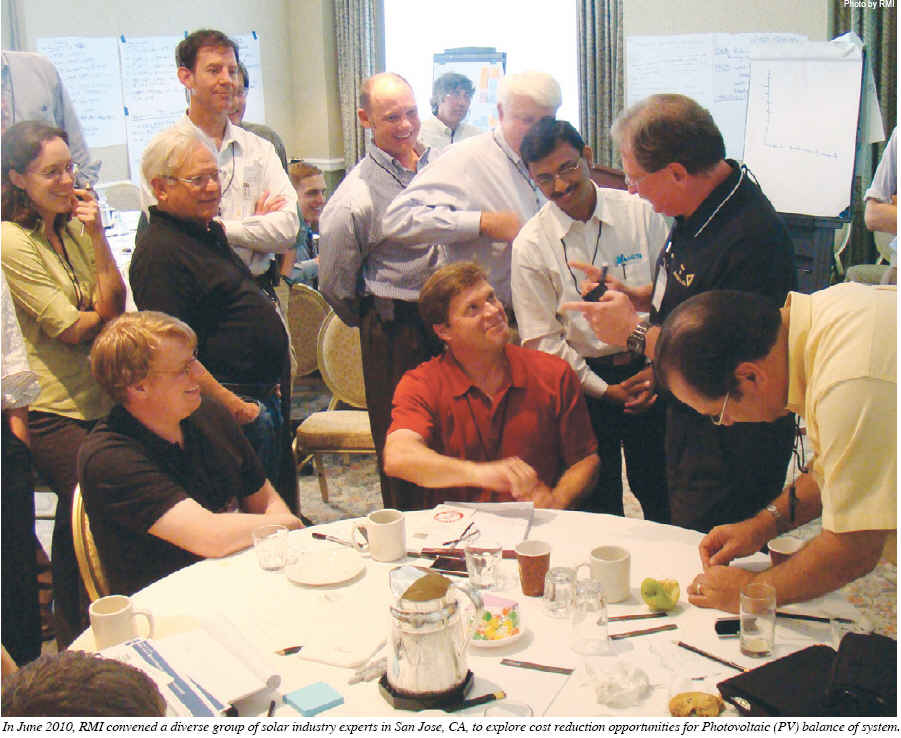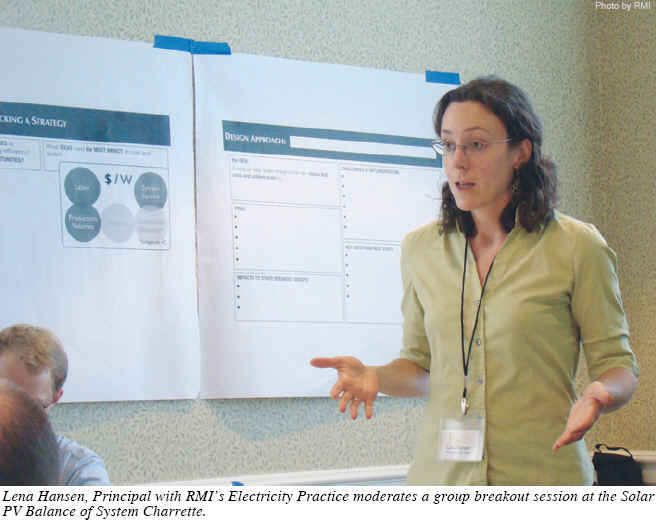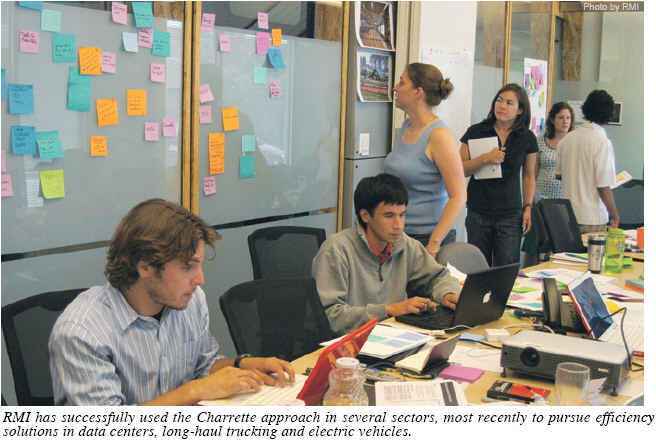By Rebecca cole

 Rocky Mountain Institute (RMI) convened a design charrette focused on the solar Photovoltaic (PV) industry. Held in San Jose, California, the event offered industry stakeholders and outside experts an opportunity to come together in the spirit of ‘coopetition’ to identify designs and other improvements that could help bring down the ‘installed’ costs (i.e., all the costs except the modules themselves) for commercial- and utility-scale PV projects. Rocky Mountain Institute (RMI) convened a design charrette focused on the solar Photovoltaic (PV) industry. Held in San Jose, California, the event offered industry stakeholders and outside experts an opportunity to come together in the spirit of ‘coopetition’ to identify designs and other improvements that could help bring down the ‘installed’ costs (i.e., all the costs except the modules themselves) for commercial- and utility-scale PV projects.
“Despite all the dynamics of the industry, we really have a situation where you have people working on piecemeal solutions so you don’t get the full power of integration,” said Stephen Doig, PhD, a program director at RMI. “You have competition that inhibits cooperation.” Bringing diverse players together, he said, unlocks a power that often isn’t available to for-profit businesses that are simply trying to get the job done.
For any industry to grow, rules have to be changed, explained Sandy Munro, a charrette attendee and CEO of Munro & Associates. “The rules are what hold you back,” he said. “But once people start thinking differently, the rules fall away.”
Enormous Potential for Solar Energy
Solar PV will play an increasingly important role in meeting the world’s energy needs, with continued double-digit annual growth predicted.
One report, released last December by the Electric Power Research Institute, states that the solar PV market is a ‘billions-of-dollars-per-year business for both module production and system installation’ However, only a tiny fraction of U.S. electricity is supplied via solar today--well under 0.1% in 2009. Installed system costs must come down in order for solar to be a viable part of the U.S. energy portfolio.
“We have a pressing need to find alternatives to fossil fuels,” Doig said. “The sun is by far the most abundant renewable resource out there. We are quite good already at converting that sunlight to electrical energy. The real issue is how we get the costs down to a level where the adoption of solar energy takes off exponentially without the need for price supports or other incentives.” While module costs have decreased significantly in the past decade, falling 33% in 2009 to current prices below US$2/W, solar PV remains an expensive energy option. This is largely due to ‘Balance of System’ (BoS) costs (racking, mounting, installation, labor, wiring, power electronics, permitting, and other process expenditures), which generally account for about half the installed cost.
Leveraging Market Opportunities
For the solar industry to continue to scale up, it must achieve major cost reductions. In the face of doubts about whether conventional solar technologies can reach widespread cost parity with other electricity sources, the solar industry can benefit from a clear roadmap of opportunities for cost reduction. To that end, the goal of the charrette was to brainstorm opportunities to reduce solar BoS costs to US$0.50/W by analyzing the structural systems, electrical components, and business and regulatory processes required for commercial and utility roof- and ground-mounted PV projects up to 20 MW in size.
The charrette focused on installation approaches for rectangular, rigid modules that are feasible within five years. Despite excitement around flexible and building-integrated thin-film products, conventional modules account for more than 95% of the market and will continue to play a large role even as new technologies become available in the near to mid term.
After three days of intensive collaboration, the group introduced specific designs and processes that, at scale, could potentially lower BoS installed costs to ~US$0.60/W to US$0.90/W, compared with ~US$1.00/W to US$2.00/W in today’s case. However, the most important metric to evaluate PV projects is levelized cost of energy, expressed as ¢/kWh. Unlike US$/W, ¢/kWh incorporates important criteria, including efficiency, solar exposure, and maintenance costs. Throughout the charrette, participants moved between these two metrics to optimize design concepts.

“One thing we realized is that when you try to attack BoS costs in one place, something pops out somewhere else,” said Sam Newman, a consultant with RMI’s electricity practice. “This process is just at the beginning, but I’m excited because I think we’re seen a lot of best practices emerge and progress toward our goals.” Some of that progress included new ideas to optimize the design approach. Managing wind load was determined to be the No. 1 challenge in terms of structural design and cost for both roof- and ground-based installations.
Meanwhile decentralizing the power inversion--from direct to alternating current--offers system performance and cost benefits if certain challenges can be overcome.
Other high-potential opportunities discussed centered around
-Parts integration and dematerialization of components
-Greater standardization of modules, system components, and regulations
-The use of high-volume manufacturing and installation processes
-Increased effectiveness throughout business and regulatory processes
No silver bullet can drive down BoS costs, warned Robin Shaffer, senior vice president of sales and marketing for Sunlink Corporation. “There is no one thing that you can take advantage of,” he said. “You are going to have to work everything in the system and figure out the best combination.”
Standards and Streamlined Design Critical to Scale
To get to scale, the solar industry has to go from ‘craft’ production to high-volume manufacturing, Munro explained.
The keys to high-volume manufacturing are streamlined designs and standards that support system installation without hindering it.
“The biggest thing is logistics, so that ‘just-in-time’ everything shows up on site,” he said, noting that ‘everything’ includes labor and pre-assembled components. Although this type of assembly is happening somewhat today, the only way a streamlined, just-in-time manufacturing model can work is if comprehensive standards are implemented across the system. “We need flexible, rock-solid standards but we don’t want them to be an anchor,” Munro said. “Standardization is going to be the first manufacturing hurdle.” The industry has reached a tipping point, according to Doug Payne, cofounder and executive director of SolarTech. “Now that the hard costs have come down, the soft costs are forcing us to standardize,” he said. “We need to do it at every single part of the value chain--manufacturing, installers, contractors, code officials, regional jurisdictions, banks, and financing options.” Once viewed through a ‘factory lens’, he explained, it becomes apparent where standardization needs to occur to increase the capacity of the entire industry.

“There are a lot of hoops industry players have to jump through, which in some cases are reasonable,” Newman added. “But in a lot of cases they’re based on an old standard or something that was for a different purpose.” With increased standardization of modules and codes, system installers can adapt accepted designs for site-specific constraints. These changes can contribute to cost reductions and industry growth in numerous ways: reduced investment risk, reduced design and permitting times and costs, and large volumes of increasingly standardized components that can be manufactured at a reduced per-unit cost.
Much of the onus of standardizing in terms of safety and reliability, Payne said, is on the industry itself.
According to David Ismay, an associate at the legal firm of Farella Braun + Martel, if standardization can be achieved, then solar PV systems up to a certain size should be a non-permit event. “It should be like buying a toaster,” he said. “It’s pre-certified, safe, and I just plug it in.”
Opportunity for Rapid Assembly and Plug-and-Play Designs
If tens of thousands of commercial-scale PV systems are going to be installed every year, reducing installation time is critical. This challenge required input from the charrette’s structural, electrical, and process break-out groups. “RMI has done a great job in terms of bringing together the industry experts and cross-pollinating ideas from different industries,” said Gene Choi, a product strategist with module provider Suntech America. “We are always looking for opportunities to have better integration with the module and with the electronics. Without them, we are a three-legged stool with only two legs.” For the electrical conversion and interconnection piece, participants looked at a variety of increasingly decentralized inverter architectures (to convert the DC module output to AC power synchronized with the grid) as a way to maximize safety and efficiency with minimal cost. Module-level power electronics offer increased flexibility in system design and installation while improving energy output.
“Having the electronics on the back of the modules is one of the final frontiers,” Choi said. “This idea of going to an integrated unit with power conversion at the module level does provide significant advantages, but obviously there are engineering and cost challenges that need to be resolved first.”
The BoS designs identified at the charrette will be just some of the myriad approaches to reducing cost that will inevitably appear on the market in the coming years. But the magnitude of the reductions associated with these designs suggests that large-scale improvement is possible. These cost reductions will undoubtedly contribute to the growth of the solar industry and to efforts to reduce dependence on fossil fuels. (Look for RMI’s report summarizing cost analysis and recommendations in late summer 2010.)
“The solar industry has been around for many, many years,” Choi said. “Right now, it is beginning to get its legs and really stretch out, really accelerate the pace, and change the world in terms of how we generate electricity and how we use electricity.” From a national policy perspective, it is important that players in the BoS sector have an environment in which they can innovate, consolidate, and grow, allowing the U.S. to become a global leader in a market with huge potential. “PV has been in the noise for a long time, but because it was small and expensive people haven’t taken it seriously on a large scale,” Newman said. “It the rate this industry is growing, there’s a strong potential for it to get bigger, but it will only happen if people recognize that it can get to the cost-effectiveness we’re imagined. It really feels like it is almost here.”
Rebecca Cole is Sector Marketing Manager with Rocky Mountain Institute’s Marketing and Communications Team (http://www.rmi.org/).
This article was first published by the Rocky Mountain Institute in Solutions Journal: 2010 and was reprinted with permission.
For more information, please send your e-mails to pved@infothe.com.
ⓒ2010 www.interpv.net All rights reserved.
|



